NUMARK SCRATCH

Setup
Drivers
Firmware: (for both Windows and Mac OSX computers). At the time this manual is written, no update for the firmware is available, but you should also check the product's official page for any updates at https://www.numark.com/product/scratch
Windows Drivers : Install the latest ASIO drivers from https://www.numark.com/product/scratch
Mac OSX Drivers : No driver is required to be installed. The Mac OS will install the necessary drivers once you connect the Numark Scratch to a USB port.
.
VirtualDJ 8 Setup
Once VirtualDJ 8 is launched, a Login Window will appear. Login with your virtualdj.com account credentials.
A Pro Infinity or a Pro Subscription License is required to use the Numark Scratch. Without any of the above Licenses, the mixer will operate for 10 minutes each time you restart VirtualDJ.
http://www.virtualdj.com/buy/index.html
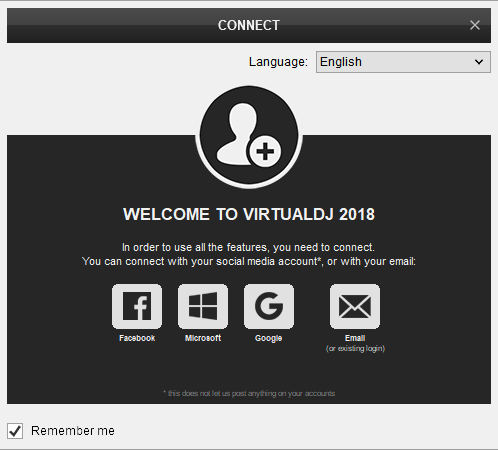
Click on the “Use Soundcard” button and VirtualDJ will automatically create and apply the pre-defined audio configuration using the built-in audio interface of the Numark Scratch
Click to OK.

The unit is now ready to operate with VirtualDJ.
MIDI Operation
The unit should be visible in the CONTROLLERS tab of Config and the “factory default” available/selected from the Mappings drop-down list.
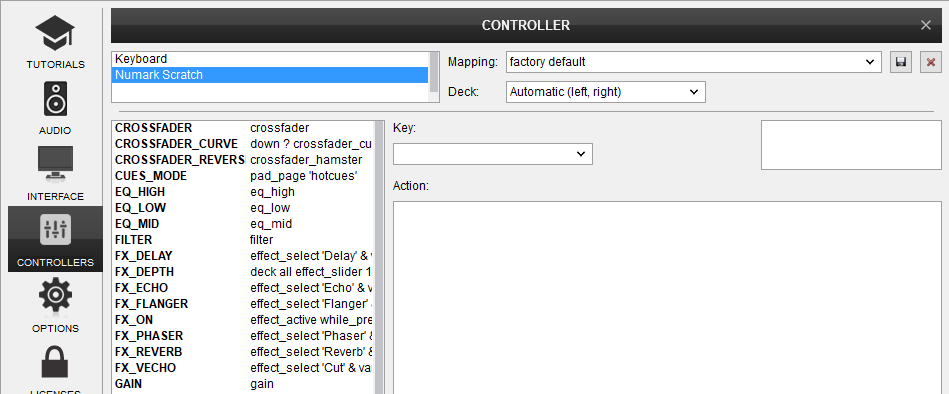
The factory default Mapping offers the functions described in this Manual, however those can be adjusted to your needs via VDJ Script actions.
Find more details at http://www.virtualdj.com/wiki/VDJ8script.html
AUDIO Setup
The Numark Scratch has a built-in USB Audio Interface with 4 output and 6 input channels. VirtualDJ offers a pre-defined Audio setup and a special button in the AUDIO tab of Config to provide that. Alternative setups can be applied in the same window.
Timecode (DVS)* configuration is not pre-configured (see Inputs & Recording for more details).
*requires Pro Infinity or Timecode License http://www.virtualdj.com/buy/index.html
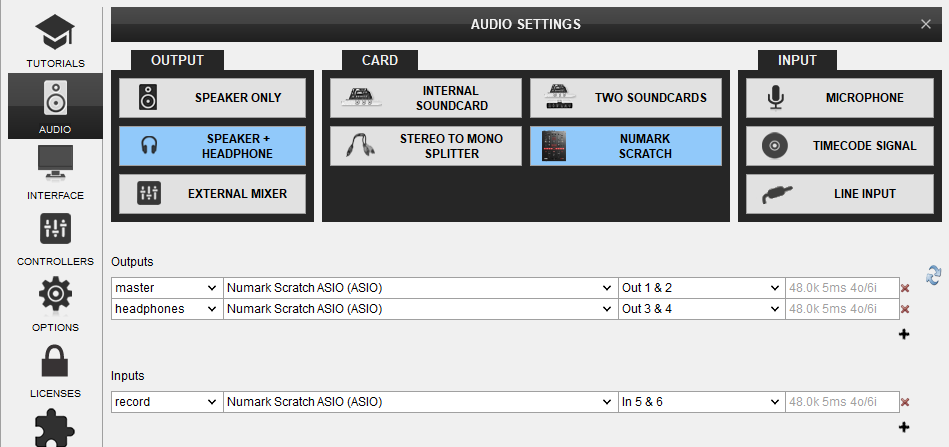
For further software settings please refer to the User Guide of VirtualDJ 8.
http://www.virtualdj.com/manuals/virtualdj8/index.html
CONTROLS

- CROSSFADER. Blends audio between the left and right assigned channels/decks.
- X-FADER SLOPE. Select the slope (curve) for the Crossfader. Choose between Smooth (left position) and Scratch (right position). Other pre-defined or custom crossfader curves can be selected from VirtualDJ Settings.
- X-FADER REVERSE. Set the crossfader to Reverse (ON position) or Normal (OFF position). When in Reverse, the crossfader will blend left and right assigned decks in reverse.
- VOLUME. Use these faders to adjust the Output Volume of each mixer channel.
- CUE. Use these buttons to send a single (toggle behavior) channel's pre-fader signal to the Headphones Channel for monitoring. When engaged, the button will be lit. Press both buttons at the same time to send both channels to the Headphones channel
- PADS 1-4.. Use the 4 buttons to trigger Pads 1 to 4 of the selected Pads page. Hold SHIFT down and then press the same buttons to trigger the assigned action of the selected Pads page. Operation depends on the selected Pads page. See further details at http://www.virtualdj.com/manuals/virtualdj/interface/decks/decksadvanced/pads.html
- PAD MODE.. Use this button to cycle through the pre-defined Pad modes (Hotcues, Sampler and Loop Rolls). Each time a mode is selected, the respective led will lit above the button and the relative Pads page will be loaded on both Decks. Note that other Pad modes (pages) can be loaded from the VirtualDJ GUI. . See further details at http://www.virtualdj.com/manuals/virtualdj/interface/decks/decksadvanced/pads.html
- FX SELECT. Use these buttons to select a VirtualDJ Effect. Selection applies on both decks. The pre-defined Effects for these buttons are Echo, Delay, Flanger, Reverb, Cut and Phaser.
- FX HOLD/ON. Use latch switches to trigger the selected Effect on Left/Right deck. Move up to enable and back to middle position to disable. Move and hold at the bottom position to temporary enable the Effect and release to disable.
- FX DRY/WET. Use this knob to adjust the 1st Parameter of the selected Effect. The adjustment applies to both Left and Right assigned decks. Hold SHIFT and then use the same knob to adjust the 2nd Parameter of the selected Effect
- LOOP. Use this encoder to select the size of the loop in beats. Push the encoder to enable/disable a loop of the selected size in beats.
Hold SHIFT and use the encoder to scroll through files or forders, depending on the selected Browser window (folders, songs, sideview). Hold SHIFT and then push the encoder to load the selected track to the Left/Right deck. While SHIFT is held, double-fast push the encoder to load (clone) the track from the other deck to the Left/Right deck - FILTER.. Use these knobs to apply a High/Low-Pass Filter. When at middle (12'o clock position), no Filter is applied and the LED will be off.
- EQ HIGH/MID/LOW. Use these knobs to adjust the low (bass), middle (mid) and high (treble) frequencies of each mixer channel.
- GAIN. Adjusts the input audio level (gain) up to +9db of each mixer channel. No boost or cut is at 12 o’clock position.
- INPUT SELECT LINE/PC. Set to PC position to route left/right VirtualDJ deck to the left/right mixer channel. Set this selector to LINE to route the audio signal from an external audio source (connected at the rear panel) to the left/right mixer channel.
Set to PC position if you are using a DVS (Timecode) system. - BOOTH VOLUME * Use this knob to control the Output level of the Booth Output (connection at the rear panel)
- MASTER VOLUME *. Use this knob to adjust the Output level of the Master Output.
- VOLUME METERS. The 2 middle series of leds indicate the output level of the Master Output. The left/right series of leds indicate the pre-fader output level of the left/right mixer channel.
- CUE MIX. Use this knob to mix between CUE and Master MIX in the Headphone channel. When all the way to the left, only channels routed to Headphones (via the CUE buttons) will be heard. When all the way to the right, only the Program mix will be heard.
- CUE GAIN *. Use this knob to adjust the output volume of the Headphones Channel
- MIC TONE**. Use this knob to adjust the Tone of the Microphone input signal (connection at the rear panel)
- MIC VOLUME**. Use this knob to adjust the volume of the Microphone input (connection at the rear panel)
* Hardware knobs, not sending any MIDI, so can't be assigned to any VDJ script action nor will control any element on VirtualDJ skins.
** Hardware knobs, not sending any MIDI, so can't be assigned to any VDJ script action. Note that the Microphone input is not part of the USB Audio interface so has nothing to do with the Microphone controls in the MASTER panel of the default VirtualDJ skins.
FRONT & REAR PANELS
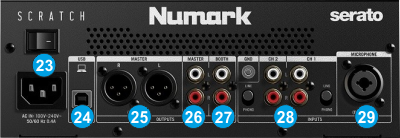
- POWER.ON/OFF. Connect a universal AC cord to the AC socket and power on the unit after all the necessary connections are done.
- USB Use a USB cable to connect the Numark Scratch with a USB port of your computer and allow the unit to send and receive audio and Midi signals
- MASTER OUT (BALANCED) Connect your amplifier using a pair of balanced XLR jacks. The level of this output is controlled by the MASTER VOL knob at the top panel
- MASTER OUT (UNBALANCED). Connect your amplifier using a pair of RCA cables. The level of this output is controlled by the MASTER LEVEL knob at the top panel
- BOOTH OUT Use a pair of RCA cables to connect the unit with your secondary output (e.g. for monitor). The level of this output is controlled by the BOOTH knob at the top panel
- CH INPUTS. 2 x Phono/LINE inputs are provided by RCA jacks (one for each Deck/mixer channel). Set the switcher to PHONO to connect turntables. or LINE to connect other media such as CD Players.
- MIC Input. Use this Input to connect a Microphone. This input is not part of the USB Audio Interface, therefore no microphone input can be added to VirtualDJ Audio setup. Its signal will be routed directly to the Master Output and its volume can be controlled from the top panel.
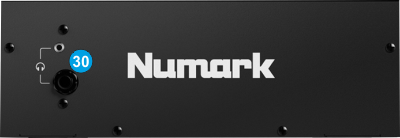
- PHONES INPUT Connect a pair of Headphones for monitoring using this socket using a ¼” or 1/8" adapter/cable.
INPUTS & RECORDING
Timecode (DVS)
VirtualDJ is offering DVS (Digital Vinyl System) support for the Numark Scratch. A Timecode Plus or Pro Infinity license is required. http://www.virtualdj.com/buy/index.html Up to 2 Timecode Inputs are available to control any software decks via Timecode CDs or Vinyls.
Both mixer Channels can accept Timecode Vinyls (rear switcher set to PHONO) or Timecode CDs (rear switcher set to LINE).
Connect your Timecode devices at the rear panel of the Numark Scratch to the Inputs CH 1 and/or CH 2 and make sure the SOURCE switchers at the top panel are set to PC position.
Open the AUDIO tab of VirtualDJ Settings and click on the TIMECODE button for VirtualDJ to auto-create 2 Timecode Inputs.

Click to APPLY.
Press PLAY on your timecode CD and/or Vinyl device and VirtualDJ will automatically detect your Timecode type and make the appropriate adjustments for best performance.
Open the TIMECODE tab of the VirtualDJ Settings and choose the CALIBRATE button if for any reason the signal is not detected (possibly due to reversed phase connections).
Click on the ON buttons from the TIMECODE panels of the Default Skin, to enable the Timecode and control the left/right VirtualDJ deck
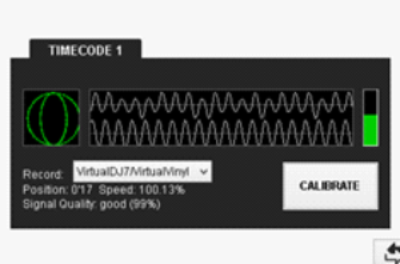

Recording
The Numark Scratch has a dedicated USB Input (channels 5,6) to record your Main Mix (default setting) and the Microphone. VirtualDJ has pre-configured this input for recording, thus no special setting is required in order to record your mix (including analogue sources and Microphone).

Simply open the MASTER center panel of the VirtualDJ GUI and click to the REC button (or BCAST for broadcasting) to record your mix.
Note that if the record line in VirtualDJ Audio Setup is missing (removed), you will still be able to record your mix properly, but without the signals from Microphone or CH1/2 Inputs
